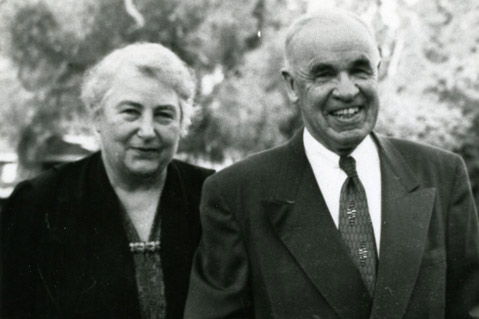The Whittaker Adobe
Built Around 1788 for Spanish Royal Presidio

The Whittaker adobe, at 123 East Canon Perdido Street, was another name for the Cañedo adobe. The adobe was built around 1788 as part of the Spanish Royal Presidio to serve as officer’s quarters. The home was granted during the Mexican era to José María Cañedo, a retired presidio soldier. In subsequent decades the adobe passed through a number of hands. Elmer Whittaker bought the building in 1920.
Whittaker was an important figure in the historic preservationist movement in Santa Barbara. A Wisconsin native, he arrived here in 1911 and took a job as a manual arts teacher at Santa Barbara High School. He soon lost that job for being, in his own words, “too independent.” He then turned to the construction business, and the 1925 earthquake gave Whittaker all the work he could handle. In the aftermath of the disaster, he worked on some 200 homes and commercial buildings.
After Whittaker bought the Cañedo adobe, a number of individuals and businesses rented the place. In 1944, Whittaker decided to restore the building and make it his home. Whittaker had a frame house that fronted the adobe demolished to open up the latter to the street. He rescued bricks and tiles from another adobe that was being torn down and used them for his new home. Today, the adobe houses the visitor center of El Presidio de Santa Bárbara State Historic Park. The adobe is both a City of Santa Barbara and state historic landmark.
Whittaker also had a hand in preserving other historic homes, including the Trussell-Winchester adobe and Charles Fernald mansion, both on East Montecito Street, and the Italianate-style Hunt-Stambach house at 821 Coronel Street. In 1957, he bought and restored the former Hernster house at 136 West Cota Street and presented it to his wife as a birthday gift. In the early 1960s, Whittaker oversaw the construction of the adobe home of the Santa Barbara Historical Museum at 136 East De la Guerra Street.
Whittaker was very interested in the history of Santa Barbara’s Chinese community. He rescued from destruction the magnificent shrine of the Santa Barbara branch of the Chee Kung Tong. The shrine was carved in China in 1898 and shipped to Santa Barbara. The tong was a secret society, dedicated to the overthrow of China’s last imperial dynasty, the Qing. Sun Yat Sen, leader of the movement that eventually overthrew the Qing, was a member of the tong. The shrine was dedicated to Kuan Kung, a war hero of the third century, and represented the spiritual center of the tong in its political struggle. The fall of the Qing in 1911 removed the rationale for the tong’s existence.
Whittaker took it upon himself to save the shrine. For 40 years he safeguarded it, and upon completion of the Santa Barbara Historical Museum, he donated the shrine to the museum. Today, the shrine forms the centerpiece of the museum’s exhibit devoted to the history of Santa Barbara’s Chinese community.
With Elmer Whittaker’s passing in 1968, Santa Barbara lost one of its most ardent preservationists.



